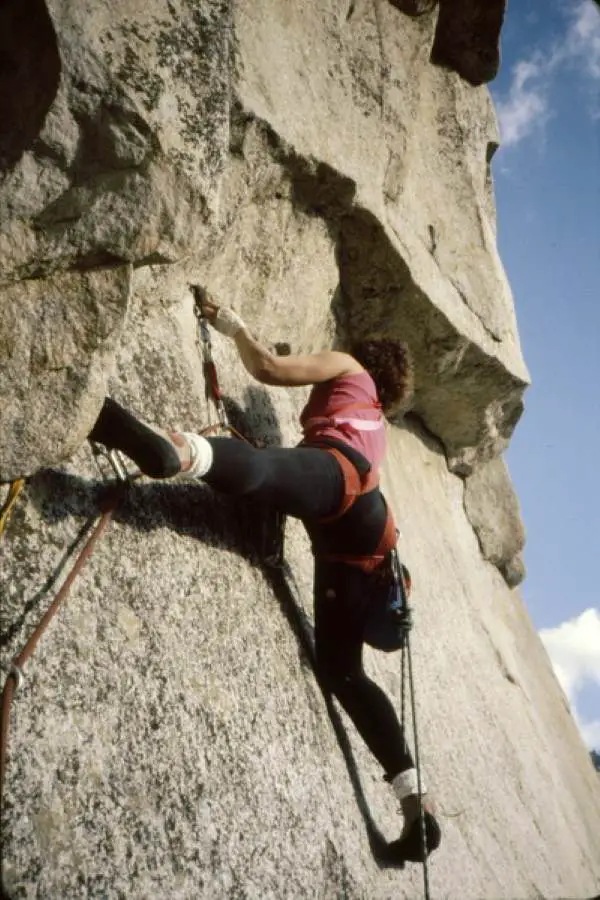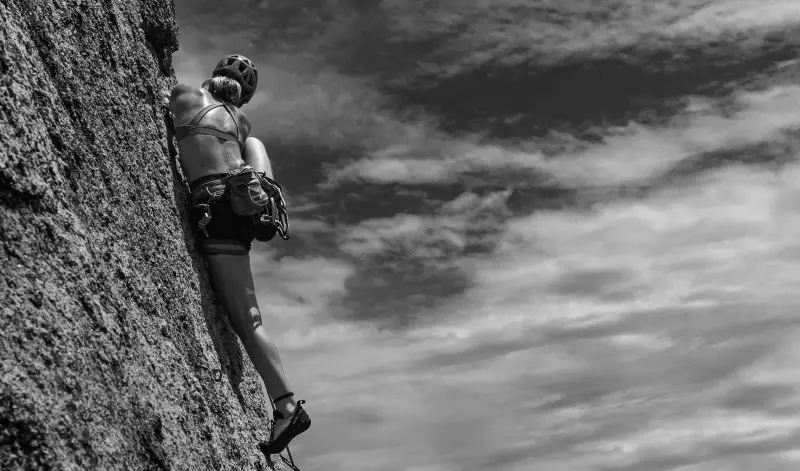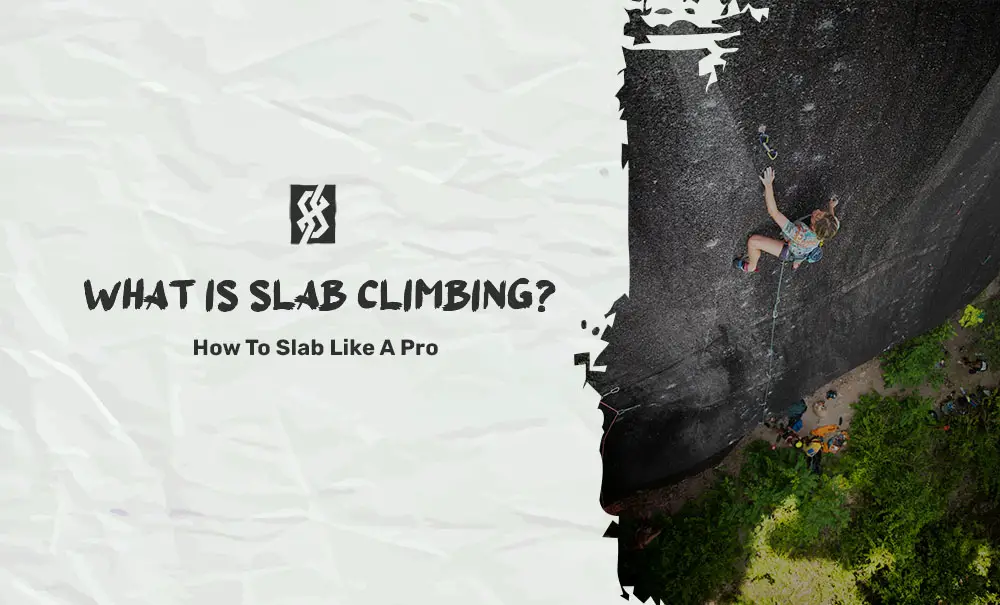Straight on the edge between art and technique, slab climbing is perhaps one of the most controversial subjects in the world of climbing. If you want to start a fiery debate with your mates over a pint after the gym, just start a conversation about slab climbing, and the whole table will go ballistic.
At first sight, it might look easy; I mean, it’s just a banked wall, right? Well, you might be right, but climbing slab is actually one of the most challenging forms of rock climbing only because it’s so counterintuitive, and more than that, WHERE ARE THE HOLDS?
What Is Slab Climbing?
Up until the 1980s, when the Boreal “Sticky Rubber” shoes appeared, slab climbing was dangerous terrain where you couldn’t place good trad protection and would have limited places to rest or find handholds.
Much like walking on the high line, slab climbing requires excellent balance and nerves of steel because one wrong foot can send you into a world of pain. This picture might help us put more into perspective why the climbers from the Golden Age were such badasses. They ventured into Yosemite, climbing all the crazy classics on El Cap, which all have at some point or another had some slab climbing involved.

Slab climbing definition, in its simplest form, is rock climbing on a rock face that is lower than 90 degrees, sometimes making the route almost vertical, but other times on simpler routes that are closer to 180 degrees than 90. The protection for slab climbing is typically quite poor, with bolts spaced far apart or with few locations suitable for placing trad climbing gear.
When Did Climbing Slab Become A Thing?
Well, the first climbing routes were usually following crack systems in the rock, making it pretty easy to find places to place gear safely and as often as you can or afford to carry up with you. Later, the famous Stone Masters from Yosemite were raising the bar with their signature climb on Valhalla, the three-pitch 5.11 slab on Suicide Wall in southern California, which newcomers had to flash in order to be part of the club. In the 1970s, when the whole movement started, climbers were still using hard-rubber shoes, which made typical slab techniques such as smearing impossible or at least hard as hell.

All of this changed in the 1980s, when the Boreal Fire shoes came out with the game-changing technology of sticky rubber. This development in climbing opened the world for more crazy and daring climbs, downgrading to almost one grade even the most difficult routes from that time.
With this new technology, climbers were able to adhere better to the wall, “clinging” to the porosities of the rock and being able to stick even the most impossible footholds. A whole new realm of techniques emerged, such as smearing and using friction, in order to pass where all hope seemed lost in the past.
Best Slab Climbing Techniques
When it comes to slab climbing, forget all you thought about rock climbing because your world will be turned upside down in a second. If you were able to go past a passage campusing, in slab it’s all about fancy footwork, balance, and strong legs.
Here is how to slab like a pro both on big walls and boulders!
Stay relaxed: A good tip whenever you go climbing is just to stay as relaxed as possible and so goes with slab. Relaxed muscles will give you an edge on balancing your moves.
Avoid pulling down: Using your hands only to keep your balance will be much more effective for you, as you’ll need as much pressure as possible on your feet.
Take your time: Slab cannot be climbed fast. This is all about footwork, not power. Find the best position for your feet and find your balance.
Heels down: The lower you get your heels on the rock, the better friction you’ll have; also, this move prevents you from getting your calves pumped fast and reduces the chances of having a bad case of the “Elvis foot”.
Hips out: This technique will put more pressure on your feet and give you an extra bit of grip, plus some confidence in your moves.
Smear: While edging will cut your contact with the rock, smearing, keeping your heels down and toes upward with the balls of your feet in direct contact with the rock, will give you some more balance and grip.
Stay positive and start on the right foot: Starting on your dominant foot might actually give you better balance and help you link your moves better, while positive talking will get you past the fear of falling into the “cheese grater” territory.
Here are some slab climbing techniques by the Queen of slab herself, Anna Hazelnutt.
Slab vs Overhang: What’s The Difference?
Overhangs are the complete opposite of slabs, just like dihedrals are the complete opposites to aretes. Typically, slab is considered ‘easier’ to climb than overhangs, but Adam Ondra’s Disbelief 5.15d route in Alberta might prove you wrong. Slab and vertical climbs tend to require more technique and footwork than overhang climbing, which requires more finger and core strength as well as a different set of techniques.

Slab Climbing Outdoors
When thinking about slab rock climbing, you start thinking immediately about outdoor spots and crags where you could give it a shot. Luckily, you will be able to find slabs on most of the classic routes in your home crag, but if you want to get really slabby, Joshua Tree in the US might just be the perfect place for you!

With granite walls as far as the eye can see, this place is perfect for you to discover the world of slab rock climbing. Whether we’re talking about pitches of complex routes or boulders, this place has it all. Of course, if you’re in the US, you should also check out Yosemite, the Moab Desert, and Looking Glass Mountain in North Carolina, all of which are perfect for finding your wildest slab routes.
Also, for our European friends, you should check out the UK for the most mind-boggling E-graded routes, such as Satan’s Slip (E1) on Lundy Island. If you are looking to do some slab bouldering, Fontainebleau in France is also a renowned bouldering spot with plenty of slabby and sloppy routes for you to feast your eyes with.

If you are looking for a more tropical place to test your slab game, check out Koh Tao in Thailand. This tiny granite island is full of slabby routes.
Slab Climbing Indoors
Gyms nowadays are not the rancid dungeons with monster overhangs and impossible-to-read spraywalls. Now you might be really surprised to find some slabby action right in your neighborhood.
It may not be as fascinating as the real deal, but improving your climbing in the gym will help you reach a whole new level.
So while working on your technique on the wall, the indoor crag might be the perfect place to also start your training:
- Work on your leg and hip mobility – when improving your mobility, all the moves that you’ll execute on the rock face will feel smoother and more controlled.
- Strengthen your core and calves – these will help you keep your stability on the rock, and after all, in slab climbing, it’s all in the legs, baby!
- Improve your balance and body position – specific exercises for working on your balance will bring you a whole lot of advantages when rock climbing and you can also start skateboarding after that!

You’re Now A Slab Pro!
The journey to becoming a slab pro involves mastering a range of techniques that prioritize balance and footwork over brute strength. Techniques such as smearing, where climbers maximize their grip by keeping the balls of their feet in direct contact with the rock, and maintaining a low heel position to enhance friction, are essential in navigating the slab terrains.
Adopt a positive mindset, enjoy the challenger and try not to cheese-grate!




Before the fire and until you could no longer get them the gailber contacts wre the best slab shoe in the valley I know I was there.
Steve “spewer” Thayer
Awesome, thanks for sharing Steve! I assume the EB was also heavily used around this time too? I once read an interview with Charles Cole who mentioned that a polish tennis shoe called the “Scat” was a really popular choice in J-Tree during the pre-Five Ten era. Was the Scat also popular in the Valley?